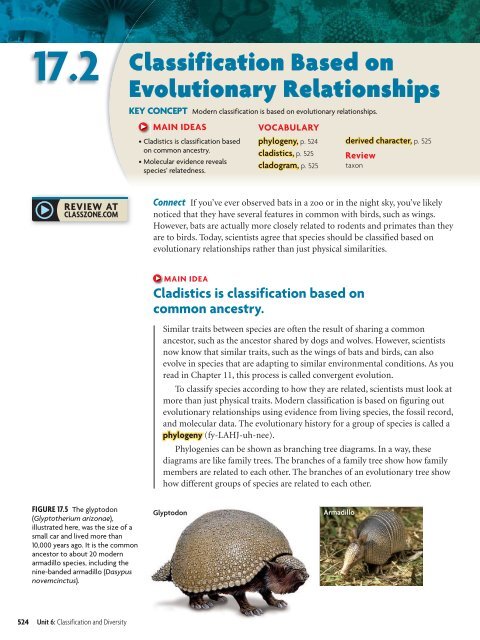Classification and Diversity
Classification and Diversity
Classification and Diversity
You also want an ePaper? Increase the reach of your titles
YUMPU automatically turns print PDFs into web optimized ePapers that Google loves.
17.2<br />
<strong>Classification</strong> Based on<br />
Evolutionary Relationships<br />
KEY CONCEPT Modern classification is based on evolutionary relationships.<br />
MAIN IDEAS<br />
• Cladistics is classification based<br />
on common ancestry.<br />
• Molecular evidence reveals<br />
species’ relatedness.<br />
VOCABULARY<br />
phylogeny, p. 524<br />
cladistics, p. 525<br />
cladogram, p. 525<br />
derived character, p. 525<br />
Review<br />
taxon<br />
Connect If you’ve ever observed bats in a zoo or in the night sky, you’ve likely<br />
noticed that they have several features in common with birds, such as wings.<br />
However, bats are actually more closely related to rodents <strong>and</strong> primates than they<br />
are to birds. Today, scientists agree that species should be classified based on<br />
evolutionary relationships rather than just physical similarities.<br />
MAIN IDEA<br />
Cladistics is classification based on<br />
common ancestry.<br />
Similar traits between species are often the result of sharing a common<br />
ancestor, such as the ancestor shared by dogs <strong>and</strong> wolves. However, scientists<br />
now know that similar traits, such as the wings of bats <strong>and</strong> birds, can also<br />
evolve in species that are adapting to similar environmental conditions. As you<br />
read in Chapter 11, this process is called convergent evolution.<br />
To classify species according to how they are related, scientists must look at<br />
more than just physical traits. Modern classification is based on figuring out<br />
evolutionary relationships using evidence from living species, the fossil record,<br />
<strong>and</strong> molecular data. The evolutionary history for a group of species is called a<br />
phylogeny (fy-LAHJ-uh-nee).<br />
Phylogenies can be shown as branching tree diagrams. In a way, these<br />
diagrams are like family trees. The branches of a family tree show how family<br />
members are related to each other. The branches of an evolutionary tree show<br />
how different groups of species are related to each other.<br />
FIGURE 17.5 The glyptodon<br />
(Glyptotherium arizonae),<br />
illustrated here, was the size of a<br />
small car <strong>and</strong> lived more than<br />
10,000 years ago. It is the common<br />
ancestor to about 20 modern<br />
armadillo species, including the<br />
nine-b<strong>and</strong>ed armadillo (Dasypus<br />
novemcinctus).<br />
Glyptodon<br />
Armadillo<br />
524 Unit 6: <strong>Classification</strong> <strong>and</strong> <strong>Diversity</strong>

















